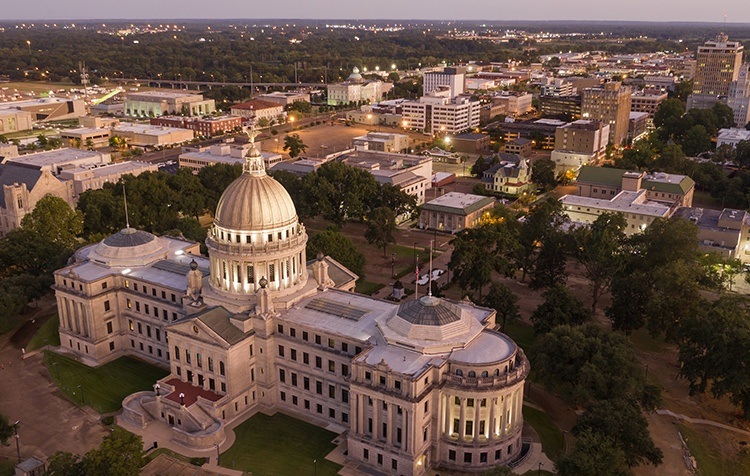These Are the Safest and Least Safe Counties in Mississippi
Where are the safest and least safe places to live in Mississippi? Whether you live in the state already or are considering moving there, you’ve probably asked yourself this question. Our SecurityNerd statistics experts have examined research on crime in Mississippi, and it turns out, the crime rates vary widely in different parts of the state.
To take a close look at crime in Mississippi, we focused on the 27 Mississippi counties that report all their crime information to the FBI. (There are 82 total counties in the state.) Those 27 counties have a combined population of 1.76 million, which accounts for about 59% of the state’s total population, as of 2018 stats.
Based on crime indexes reported by the FBI, here are the counties SecurityNerd has identified as the safest and the least safe.
Why Trust Us

Our team at SecurityNerd not only utilizes the most up to date crime data from the FBI and local police departments, we also ensure that all findings are reviewed with our resident expert, Officer James Banta.
With over 24 years as a police officer in Biloxi, Mississippi, Officer Banta has seen it all and is excited to offer his expert advice in order to help consumers better educate themselves on what it takes to keep themselves, their families and their homes safe.
The 5 Safest Counties in Mississippi
| County Name | Crime Index | Population as of 2018 | Police budget (in millions) | # Drug overdose Deaths | Rank by budget* | Rank by Drug overdose Deaths** |
|---|---|---|---|---|---|---|
| Choctaw | 34 | 8278 | $1.20 | 2 | 26 | 6 |
| Marshall | 35 | 35451 | $3.20 | 2 | 18 | 6 |
| Clay | 38.9 | 19386 | $1.70 | 0 | 23 | 1 |
| Lamar | 44 | 62447 | $8.00 | 8 | 7 | 20 |
| Sunflower | 44 | 25735 | $1.60 | 2 | 24 | 6 |
* Low rank means high police budget
** Low rank means low number of drug overdose deaths
1. Choctaw. Crime index: 34.0
Topping the list is Choctaw County, whose website describes it as “a small county full of southern hospitality where everyone waves, nods and says hello.”
Choctaw has only three towns and a population of just 8,278 people. So it comes as no surprise that the crime rate is low, says Officer James Banta, a retired Mississippi police investigator and SecurityNerd expert.
“Places with a smaller population tend to be safer simply because they’re more spread out,” says Banta.
He notes that in a tight-knit community like those in Choctaw, people may be less likely to commit crimes like break-ins, but also notes that the stats only tell us about reported crimes.
2. Marshall. Crime index: 35.0
Coming in at #2, Marshall County sits at the northern border of the state, close to Memphis, Tennessee. A large chunk of Marshall County is made up of the Holly Springs National Forest.
At 35,451 people, Marshall boasts a higher population than Choctaw, but it’s still on the small side. Its low crime rate could be thanks to Marshall County’s investment in its police force, which has a budget of $3.2 million. Banta explains that bigger budgets can mean more police officers, and a prominent police presence can help to discourage crime.
3. Clay. Crime index: 38.9
Clay, dubbed “the ultimate experience in graceful southern living,” only has 19,386 people living in its borders. Again, Banta cites more spread-out living as a potential reason for the low crime index. It’s also worth mentioning that there were zero drug overdose deaths in the county in 2017, which could be a sign (but not conclusive evidence) that drugs are less of a problem in Clay than in other places.
4. Lamar. Crime index: 44.0
Lamar County, Mississippi, is part of the Hattiesburg metro area. At 62,447 people, it’s the second-fastest growing county in the state. But it also manages to keep its crime index low, at least partly thanks to its $8.0 million police budget. Again, a larger police budget and force tend to influence an area’s crime rate in a positive way.
5. Sunflower. Crime index: 44.0
“Everyone wants to behave in Sunflower County because that’s where the state penitentiary is,” jokes Banta.
But in all seriousness, Sunflower has a relatively low crime index despite its low police budget of $1.6 million for 25,735 people.
It’s a rural county, made up of mostly farmland, and Banta says either not a lot of crime is happening or isn’t being reported. “Some of the problems they do have in Sunflower county are from people coming from elsewhere,” he says. “They do have somewhat of a drug problem, but that may simply because there’s just not a lot there for people to do.”
The 5 Least Safe Counties in Mississippi
| County Name | Crime Index | Population as of 2018 | Police budget (in millions) | # Drug overdose Deaths | Rank by budget* | Rank by Drug overdose Deaths** |
|---|---|---|---|---|---|---|
| Scott | 65.8 | 28287 | $1.80 | 4 | 22 | 14 |
| Jackson | 66.2 | 143277 | $14.00 | 31 | 3 | 25 |
| Washington | 67.9 | 45063 | $3.50 | 4 | 16 | 14 |
| Panola | 69.1 | 34178 | $3.10 | 6 | 19 | 17 |
| Marion | 70 | 24715 | $3.50 | 5 | 16 | 16 |
* Low rank means high police budget
** Low rank means low number of drug overdose deaths
1. Marion. Crime index: 70.0
“Even though there aren’t a lot of people there, there seems to be a lot of crime,” says Banta, of Marion County. The 24,715-person county has the highest crime index on the list. While in Marion County, the violent crime index (murder, manslaughter, rape, robbery, aggravated assualt) is 20.5—lower than the national average of 22.5—property crime (burglary, larcony, motor vehicle theft and arson) has an index of 45.4, which is much higher than the national average of 35.4.
2. Panola. Crime index: 69.1
Panola’s violent crime index is 25.9 and its property crime index is 55.5 — both higher than the national averages. The county’s relatively high crime rate could be partially due to travelers passing through the county, says Banta. It shares a border with Lafayette County, home of the University of Mississippi (a.k.a. Ole Miss), and it also holds Interstate 55, which leads to Memphis. “I-55 is not a heavily traveled drug corridor, but there is dope that runs through it, so they do make some arrests there,” says Banta.
3. Washington. Crime index: 67.9
Washington County, Mississippi, has an unemployment rate of 7.9%, which is higher than the state average (5.6%) and the national average (3.8%). Plus, it has the fourth highest rate of drug overdose deaths of Mississippi counties with reported stats. These factors are likely contributors to its high crime index.
4. Jackson. Crime index: 66.2
“They do have some problems in Jackson,” says Banta, who notes that the county borders Alabama and so some of the crime may be from travelers and people attending college sporting events. “There may be a lot more fistfights on Saturdays during football season than in other counties,” he says, for example.
It’s also not small, as far as Mississippi counties go. It has a population of 143,277 people—the fifth highest of the counties included in the stats—which its $14.0 million police budget might not completely offset.

5. Scott. Crime index: 65.8
Scott County’s violent crime (26.1) and property crime (37.1) are both slightly higher than national averages. At $1.8 million for its 28,287-person population, the county’s police budget is on the low side.
“Interstate 10 is a big drug corridor,” says Banta, in theorizing about Scott County’s high crime index. “There are likely a lot of drug arrests that go into that number.”
Key Takeaways
Areas with higher population tend to have higher crime rates. “When there are more people, somebody’s going to get on somebody’s nerves,” Banta says. But, less populated counties that get a lot of travelers may get additional crime from those who pass through.
Reported crime doesn’t tell the whole story. Banta points out that not all crimes are reported to police and suggests that in some rural areas, people might be less inclined to call law enforcement when they have a problem. Plus, some police departments may report and categorize crimes differently than others do.
Utilize Local Police
Remember: Safety in your county is more than just a statistic. And within that county are many areas that can differ drastically. Your local police department may be able to give you more specific information about crime in your city, town or neighborhood.
“If you’re thinking about moving somewhere—not just in Mississippi but anywhere in the U.S.—and you know the house or there’s a particular street or an area where you’re looking, contact the local police department,” recommends Banta.
Ask them about the types of police calls that are common in that neighborhood or part of town. Banta says he did this himself when he was looking for a new home, and chose the part of town he wanted to live in based on the information he was given.
“The resources are there and people don’t know they can use those resources,” he says. “Use them.”
About the Author
 Elena Donovan Mauer
Elena Donovan Mauer
Elena Donovan Mauer has written for Real Simple, Self, Good Housekeeping, Parents, The Knot, The Bump, and other publications. Elena is also a soccer mom, adjunct professor and taco enthusiast, who can be found antique shopping and singing in her kitchen. She lives in the Hudson Valley of New York with her husband and two sons.
